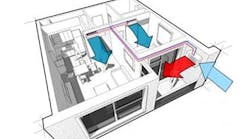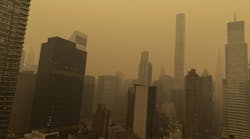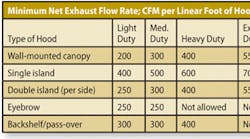If you're getting calls about comfort and humidity problems in restaurants or high-end homes, and you arrive to find all the heating and cooling equipment operating properly, take a close look at the kitchen exhaust fan. It may be that a lack of make-up air to the fan in the kitchen is throwing the entire building out of balance.
I work in the cooling-dominant market of coastal South Carolina, and have seen several problems with kitchen exhaust fans — not caused by the fans themselves, but by what happens to the building conditions when the fans are not set up or operating properly.
Hot Patrons Want Cool Dining
For example, we recently received a call from a restaurant owner who was having trouble keeping his establishment's dining room cool. In addition to the comfort problems, the indoor unit cabinet and ducts above the dropped ceiling were sweating. The ceiling tiles got wet and fell out of the ceiling. To make matters worse, this happened by the main door into the restaurant.
We sent a technician out, and he checked the filters, made sure the equipment was properly charged, checked the ducts for leakage, and made sure the strip heaters weren't accidentally turning on. He also cleaned out the drain line because the indoor unit was wet inside and out.
The next day we were called again. This time we checked system airflow with a flow hood, and did a capacity check. Our readings and calculations showed that the 15-year-old, 2.5 ton heat pump was still putting out 2¼ tons of cooling.
Then we checked the makeup air registers in the kitchen near the exhaust hood. The makeup air fan was not working. Without makeup air, the kitchen exhaust hood fan was pulling the whole restaurant into a negative pressure. Outside air coming in the front door was overloading the heat pump cooling the dining room, meaning the patrons were getting hot. It was also pulling air in through the vented attic, then down through the dropped ceiling. The ducts and the indoor unit cabinet were sweating, causing the ceiling tiles to get wet.
The whole problem was a lack of makeup air in the kitchen hood system, not a faulty heat pump. But until we performed air diagnostics on the building, the heat pump was assumed to be at fault.
No Fun in Moldy Game Room
We had another customer who had a private supper club. The establishment had some mildew and mold growing in a private upstairs game room around the windows, light fixtures, and electrical outlets. In addition, the new (and correctly sized) heat pump that we had installed could not adequately cool the space.
We investigated, and found the space was under a strong negative pressure with respect to the outside, causing significant infiltration to overload the cooling capacity of the heat pump. We looked in the attic for duct work that may have come apart, which would have discharged air to the outside and pulled the room into a negative pressure. But the ducts were in good shape and well-sealed.
When we checked the kitchen hood exhaust fan and tested the exhaust and makeup air, we found the makeup air to be deficient. I found a loose belt on the makeup air fan and the motor pulley fully opened. I adjusted the pulley and tightened the belt on the makeup air fan. The private game room started cooling better and the mold problems disappeared.
Unbalanced Fan Causes High Humidity
Another restaurant owner called us with complaints of high humidity and poor cooling. In addition, the floor by the front entrance was wet, creating a slipping hazard.
We serviced the rooftop units, but the indoor humidity stayed high and the floor by the front door stayed wet. Then we noticed that when you pulled open the door a little, negative air pressure inside would pull it back closed. We went into the kitchen and measured the exhaust and makeup air at the hood. The makeup air was deficient. We went on the roof and found the fan belts on the makeup air units for the kitchen hood had never been installed.
There was a register blowing cold air on the floor by the front door. Whenever someone came in the front door, air was pulled in from the outside by the negative pressure in the building. The cold floor cooled that air below its dew point, causing condensation to form on the floor. The solution was to ensure there was proper makeup air in the kitchen.
We were also called to an oceanfront restaurant that would not cool. When the stove hood exhaust fan was turned on, the doors between the kitchen and dining room were pulled open in the direction of the kitchen. Then outside air was pulled through the restaurant's front doors and drawn through the dining room into the kitchen.
We measured the kitchen hood exhaust and makeup air difference, and found the added makeup air into the restaurant was adding 18 tons of cooling load. The salt air had eaten up the blower wheel and casings of the two evaporative coolers. We replaced the evaporative coolers and the air conditioning problems disappeared. This was easier than adding 20 tons of air conditioners to handle the extra air infiltration.
Similar Problems Can Exist in Homes
These problems aren't unique to restaurants. Many high-end (and even some mid-range) new homes are being equipped with high power downdraft stove exhaust fans. Depending on local climate conditions, they can have a serious effect on the cooling system's performance and the home's comfort.
Last year, we visited a house with a downdraft stove fan that had a 10-in. round duct on the exhaust fan. It was pulling 300 CFM out of the house. In our climate, that removes 27,000 Btuh of cool air from the house at peak conditions. There were no provisions made for makeup air for the stove in this home, and consequently, the homeowners were seeing mold growth around many of the penetrations in the building envelope as humid, outside air was drawn in to supply the exhaust fan.
In our cooling-dominant climate, these unbalanced exhaust fans were causing cooling and humidity problems. In heating dominant climates, unbalanced fans could cause heating and over dry air conditions. So, the next time you encounter these types of challenges, check the exhaust and makeup air. And, whenever you install a new (or larger) exhaust fan, make sure you're also providing the makeup air to keep the system balanced and controlled.
Remember, air conditioning begins with air.
Kevin O'Neill, CM, is the co-owner of O'Neill-Bagwell Cooling & Heating, Myrtle Beach, SC. He has 33 years experience in the HVAC service business, is a 26-year member of Refrigeration Service Engineers Society (RSES), and was a finalist in the 2005 NATE Certified Technician Competition. He can be reached at 843/385-2220; e-mail [email protected].










